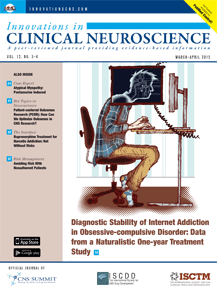Welcome to the March–April 2015 issue of Innovations in Clinical Neuroscience (ICNS). First, I would like to call to your attention the supplement that accompanies this issue of ICNS, presented by the International Society for CNS Clinical Trials and Methodology (ISCTM), of which ICNS is the official publication. In this supplement, the ISCTM Publications Committee presents three articles based on content from ISCTM’s Autumn 2013 and Winter 2014 conferences. According to the ISCTM’s Publications Chair, Dr. Judith Dunn, each article seeks to identify obstacles in current approaches to drug development and offers “thoughtful, experience-driven suggestions on how to more effectively identify and develop new medications that address unmet medical needs in the area of neuroscience.” We invite our journal readers to access this important supplement by clicking here for the e-edition (a digital replica of the printed version) or here for the website version.
We start this issue of ICNS with a study by Bipeta et al titled, “Diagnostic Stability of Internet Addiction in Obsessive-compulsive Disorder: Data from a Naturalistic One-year Treatment Study.” Here the authors discuss both sides of the controversy surrounding whether internet addiction (IA) should be categorized as a primary psychiatric disorder or the result of an underlying psychiatric disorder. The authors hypothesize that IA is a manifestation of underlying psychopathology, the treatment of which will improve the IA. In this study, the authors specifically examined IA among subjects with obsessive-compulsive disorder (OCD). All enrolled patients with OCD alone (n=27) and OCD and IA (n=11) were treated for OCD for a period of one year. At 12 months, only two of the 11 patients with OCD and IA continued to meet the criteria for IA, and the authors concluded that treatment of the underlying disorder, in this case OCD, improved IA, supporting their hypothesis that IA is a symptom of an underlying disorder and not a primary disorder itself. The authors state several limitations to their study that might impact their conclusions and acknowledge that more carefully controlled studies are needed to resolve the diagnostic controversies surrounding IA.
Next, Kolikonda et al present a case report titled, “Atypical Myopathy: Pentazocine Induced,” which describes a case of atypical myopathy that included wasting of musculature in the gluteal region bilaterally and stiffness and woody induration in the legs of a 42-year-old man as a result of one and a half years of intramuscular injections of pentazocine. Though its use, particularly in intramuscular form, is rare in this country, pentazocine may still be used in areas less medically advantaged, and clinicians should be alerted to this potential side effect and avoid repeated administration of intramuscular pentazocine.
Following this, Wadekar et al present this month’s installment of “Hot Topics in Neuroscience.” In their article, “Patient-centered Outcomes Research (PCOR): How Can We Optimize Outcomes in CNS Research?,” the authors describe the PCOR protocol and how it can be used to increase patient involvement in health-related decisions by providing better information of benefits, risks, and options as they pertain to patient health. The authors specifically discuss how this protocol might be particularly beneficial among patients with certain CNS conditions who might be challenged in their capacity to consent. The authors offer suggestions on how PCOR, with specific ethical safeguards in place, might be incorporated into trial methodology by research organizations who seek to enroll certain types of CNS patients for drug development studies in an effort to reduce these patients’ vulnerabilities while protecting their autonomy.
Next, in this month’s installment of “The Interface,” Sansone and Sansone present their article, “Buprenorphine Treatment for Narcotic Addiction: Not Without Risks.” The authors review the risks associated with the medication-assisted treatment programs for opioid/opiate addiction that utilize buprenorphine and buprenorphine/naloxone. While the authors acknowledge that most clinicians will never prescribe buprenorphine or combined buprenorphine/naloxone, the authors encourage all clinicians to become familiar with and continually monitor the clinically fluctuating risk/benefit equation of buprenorphine and buprenorphine/naloxone, as most clinicians are likely to encounter patients in their daily practice from time to time who are either prescribed these medications by licensed professionals or who are abusing these medications. (For additional information on medication-assisted treatment for opioid/opiate addiction, please see the letter to the editor in this issue titled “Opioid Abuse and Overdose Crisis: New Treatment Available Yet the Controversy Continues Between Harm-reduction Treatment and Abstinence Treatment.”)
And finally, we wrap up the issue with this month’s installment of “Risk Management” presented by McNary titled, “Avoiding Risk with Nonadherent Patients.” Here the author addresses potential liability exposure when dealing with patient nonadherence and offers clinicians suggestions for identifying and managing patients who are either intentionally disregarding treatment recommendations or are unable to follow treatment recommendations for some reason. (For additional information on patient adherence, please see the letter to the editor in this issue titled, “Adherence with General Healthcare Among Internal Medicine Outpatients With Mental Health Treatment Histories.”)
As always, we hope you enjoy the issue and welcome your feedback and submissions.
Sincerely,
Amir Kalali, MD
Editor, Innovations in Clinical Neuroscience






